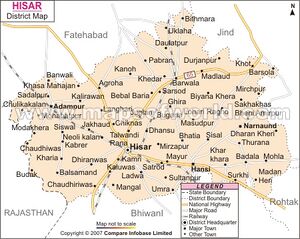Siswal

Siswal (सीसवाल) is a village in Adampur tehsil in Hisar district of Haryana. It is a site of Indus Valley Civilization of Chalcolithic age. It is a typesite for Siswal culture dating around 3800 BC, also known as Sothi-Siswal culture.
Location
Site of Indus Valley Civilization
Pre-Harappan period: Siswal is a site of early Harappan culture, otherwise known as "Pre-Harappan" civilization. The Pre-Harappans were known to live in mud houses with thatched roofs. The culture focused mainly on agriculture as an occupation, domesticating animals such as cows, bulls, pigs and goats. They used wheel made red pottery which was often painted on.
They were said to have a black complexion, with curly hair and a flat nose, and according to archaeologists, stayed in the Haryana area around 2700 BC. Due to these features, Siswal is a village of great archaeological importance within the Indian subcontinent.
Sothi-Siswal culture: The Indus Valley Civilization ceramic period of Sothi-Siswal culture was relevant within the civilization. Sites around Siswal were excavated by archaeologist Suraj Bhan in different phases revealing an remarkable cultural sequence. Sothi, in Uttar Pradesh, has similar cultural remains.
During a three year period from 1967, Bhan was able to excavate ninety seven sites in the area in order to reach conclusions on the Harappan culture. Upon conducting the small scale excavations, Suraj Bhan was able date a time period ranging from Kalibangan to Late Harappan culture within the region. From here, he brought light to ceramic industry associated with the region known as Siswal, given the same name of the area that these ceramics are found in.
Early Indus Valley Civilization ceramic now as of recent have been classified in order to make a datum line for ceramic studies in this area. Known as the 'six fabrics of Kalibangan', this term is now known by most scholars who are working within this area of archaeological research.
According to Tejas Garge, Sothi culture precedes Siswal culture considerably. Sothi culture may be as early as 4600 BCE, while the earliest Siswal A layer is dated 3800-3200 BCE, and is equivalent to the Middle and Upper layers of Sothi.[1]
The mound located within the village of Siswal is 300m to the north of the village on the left bank of the Chautang Canal as reported by Bhan. The maximum habitation deposit found here was 1.25 m above the natural soil.
The cultural deposit is divided into Siswal A and Siswal B in which A was characterized by the presence of classical Kalibangan I – A to E fabrics. Bhan has also noted a clear trend of evolution in typology from the lowest to the upper levels. A few examples of the sherds found at the site are described in the words of Bhan himself below:
- Miniature pot of red ware with short out-curved rim and thick horizontal black band on neck and lower part of body portion,
- Upper portion of the red ware jar with simple out-turned rim and black slip on the rim and neck portion,
- Fragment of a red ware sherd with horizontal black band on the rim portions and incisions in form of horizontal and criss-cross lines,
- Fragment of central portion of a red ware dish with incisions in form of concentric circle,
- knob (?), shaped like mushroom, 9 cm in height solid, on top potion a circular concentric circle incised with fish motif within.
Upon the excavations at Siswal, Suraj Bhan put forward an idea of the existence of a parallel culture to the Harappans within the region.
Ceramic industry: The ceramic industry of Siswal is divisible into three groups, Siswal A yielded the Kalibangan I Ware, with all the typical fabrics (A to F).
Fabric A is painted with white pigment in addition to the black.
In Siswal B, the late Siswal phase, both the Late Siswal and the Harappan Wares are found. This second phase is characterized by the austerity in shape and design, along with a disappearance of painted white pigment. Better potting technique can also be seen within this second group. It is marked by evolved Kalibangan I shapes bearing only black paintings.
Although all the six fabrics survive in the ware, it lacks in variety in shapes and designs and is generally sturdier and better plotted than the Kalibangan I ware of the earlier phase. In accordance to this, Bhan separated non-Harappan sites on presence of a worn out medium thick red ware treated with red slip and painted with black bands, though he admits similar typology and firing with these and Siswal wear.
Lastly the third and final group is characterized by the appearance of medium fabric made through a fast wheel and treated with a red slip in the case of vessels.
Along with these artifacts found at the Siswal site, others found include terracotta bangles with black paint strokes, terracotta beads, terracotta sling-balls, and terracotta triangular cakes.
Due to the abundance of Harappan archaeological history within the Siswal area, the site continues to be a hot spot within the country of India for tourism as well as archaeological inquiry.
Similar pottery is also found at Lohari Ragho.
History
Jat Gotras
Population
(Data as per Census-2011 figures)
| Total Population | Male Population | Female Population |
|---|---|---|
| 12494 | 6579 | 5915 |
Notable persons
External Links
- Information about Siswal village - villageinfo.in website
- http://www.haryana21.com/distt-villages/village.php?villageid=1475&village=Siswal
- https://en.wikipedia.org/wiki/Siswal
References
- ↑ Tejas Garge (2010), Sothi-Siswal Ceramic Assemblage: A Reappraisal. Ancient Asia. 2, pp.15–40. doi:10.5334/aa.10203
Back to Indus Valley Civilization/ Jat Villages

